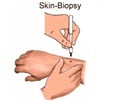Allergic Response –What Happens
Hives are a common allergic reaction that mostly affects the skin.
During an allergic attack, the IgE antibodies get themselves attached to the mast cells (usually found deep in the skin, lungs and mucous membranes) which are programmed to release a wide range of chemicals, including histamine.
During an allergic response, histamine opens the blood vessels, causes redness of the skin, itching and causes membranes to swell. It is mainly responsible for most of the symptoms associated with allergies.
The swelling or blotchy appearance is due to the leakage of the blood plasma through the opening or there tiny gaps that line the small blood vessels (called capillaries) in the skin.
In some rare and hereditary cases of allergy, a drug or even a bee sting can trigger a profound release of chemicals from our circulation into the third spaces of the body causing shock along with swelling or angioedema and this kind of reaction is called anaphylaxis. This can be life threatening and needs immediate medical treatment.







